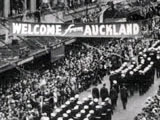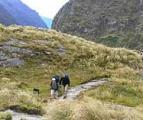What happened that day?
See historic events for any day of the year by entering the date below. Why not try your birthday?
Kiwi of the Week
Today in History

1940 100,000 welcome home HMS Achilles crew
The Battle of the River Plate in December 1939 was the Allies’ first naval victory of the Second World War. The involvement of the cruiser HMS Achilles, which was largely manned by New Zealanders, was greeted with jubilation back in New Zealand.
The German pocket battleship (heavy cruiser) Admiral Graf Spee had been commerce raiding in the Atlantic and Indian Oceans since the start of the war in September. On 13 December it was intercepted by three Royal Navy cruisers, Exeter, Ajax and Achilles, off South America’s River Plate estuary. The Exeter was severely damaged and forced to retire from the battle. The Ajax and Achilles also suffered hits but shadowed the Graf Spee as it sought refuge in Montevideo, the capital of neutral Uruguay.
While his ship was repaired in Montevideo, the Graf Spee’s captain, Hans Langsdorff, believed that the British were assembling an overwhelming force to prevent an escape. Rather than put his men at risk, he decided to destroy his ship. On 17 December, after its crew had been taken off, the Graf Spee was scuttled in the shallow estuary. Langsdorff committed suicide threedays later.
The crew of the Achilles were hailed as heroes when they returned to New Zealand in February 1940. Parades in Auckland and Wellington (on 2 April) drew huge crowds.
Image: return of HMS Achilles

1904 First step in creation of Fiordland National Park
940,000 ha in western Southland was permanently reserved for a national park. The 1952 National Parks Act formally created what has become New Zealand’s largest national park and one of the largest in the world.




















